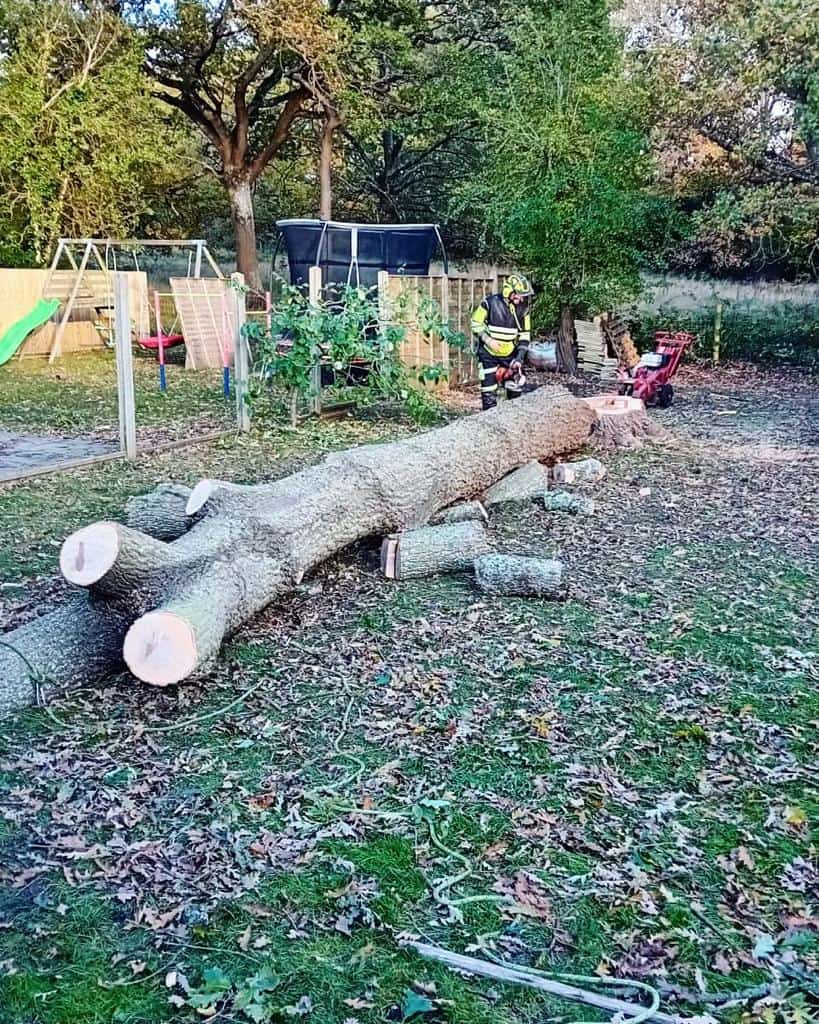Introduction
When a tree develops cracks, splits, or structural failures, swift and skilled intervention is crucial. These problems can arise suddenly, particularly during periods of strong wind, heavy rain, or after a long spell of drought. For property owners in Southsea, the consequences of ignoring such damage can be severe — from falling branches to full tree collapse.
At LM Tree Surgery Southsea, we specialise in emergency tree surgery designed to make trees safe, stable, and healthy again. Understanding the causes and warning signs of structural tree failures can help you act quickly before small issues turn into major hazards.
Understanding Tree Cracks and Splits
What Are Tree Cracks?
Cracks in trees usually form when internal stress exceeds the wood’s ability to resist tension. These fissures can appear on the trunk, at branch junctions, or along limbs. They may start small but can deepen with movement or weather exposure, making them a common precursor to branch or trunk failure.
Why Do Splits Occur?
Splits often develop where a branch forks or where competing stems grow too close together — a condition known as included bark. The trapped bark between the stems prevents strong wood-to-wood bonding, weakening the connection. When wind or weight applies pressure, one side can split away from the other.
Common Causes of Structural Failures
- Storm damage: High winds or saturated ground can cause bending or uprooting.
- Overextended limbs: Long, heavy branches place pressure on attachment points.
- Decay or rot: Fungal infections can hollow the core, leaving the tree structurally unsound.
- Age and growth patterns: Older trees or those with poor pruning history are more susceptible.
The Importance of Emergency Tree Surgery
Preventing Escalating Damage
Once a tree has cracked or split, the damage rarely heals on its own. Instead, it tends to worsen over time, especially if exposed to moisture or additional stress. Emergency tree surgery from LM Tree Surgery Southsea can prevent these issues from escalating into full failures.
Protecting Surrounding Property
Falling limbs or collapsing trees pose a serious risk to nearby buildings, vehicles, and pathways. Acting promptly not only safeguards your property but also helps preserve the health of the tree wherever possible.
Preserving Tree Health
In many cases, a damaged tree doesn’t need to be felled. Professional intervention can stabilise it through pruning, bracing, or selective removal of compromised sections, allowing it to recover naturally.
Common Emergency Tree Surgery Solutions
1. Crown Reduction and Rebalancing
When damage causes uneven weight distribution, crown reduction helps restore balance. By carefully reducing canopy size, arborists can relieve pressure on compromised branches, preventing further splitting or collapse.
2. Cabling and Bracing
For trees with splits or weak junctions, installing support systems such as steel cables or flexible braces can provide much-needed reinforcement. These systems stabilise the structure while allowing natural movement and continued growth.
3. Deadwood Removal
Removing dead or fractured branches is essential to reduce the risk of falling debris. It also prevents decay from spreading to healthy wood and improves the overall safety of the tree.
4. Selective Pruning
By strategically pruning damaged or overloaded limbs, arborists can reduce strain on the tree’s structure while promoting regrowth and vitality. Pruning also improves airflow and reduces wind resistance — two key factors in preventing future failures.
5. Controlled Tree Removal (When Necessary)
In some cases, the damage may be too extensive for safe recovery. When the structural integrity of the tree cannot be restored, controlled removal ensures safety while minimising disruption to the surrounding area.
Warning Signs That Require Immediate Attention
- Deep vertical or horizontal cracks in the trunk
- Fresh splits along large limbs or branch unions
- Sudden leaning after strong winds
- Heaving soil or exposed roots at the base
- Large sections of deadwood or broken limbs
- Hollow sounds when tapping the trunk
If any of these signs appear, it’s best to contact LM Tree Surgery Southsea as soon as possible. Our qualified arborists can assess the situation and take prompt action to secure the area and treat the problem safely.
The Role of Preventative Tree Care
While emergency surgery is sometimes unavoidable, regular tree maintenance significantly reduces the risk of structural damage. Routine inspections, formative pruning, and canopy management all help maintain balance and strength.
Our arborists in Southsea recommend scheduling annual tree health checks, particularly for older or high-value trees near property boundaries or public areas. Identifying weak points early allows for minor corrections before emergencies arise.
Why Choose LM Tree Surgery Southsea
At LM Tree Surgery Southsea, we provide professional emergency response and expert care for damaged or unstable trees. Our team combines technical expertise with advanced equipment to handle even the most complex situations quickly and safely.
We assess each tree individually, identifying the safest and most effective course of action — whether that’s stabilisation, selective pruning, or complete removal when absolutely necessary. Every step is carried out with precision and respect for the surrounding environment.
Conclusion
Cracks, splits, and structural failures can occur without warning, especially during storms or high winds. However, with prompt and professional attention, many trees can be saved and restored to full health.
For property owners in Southsea, LM Tree Surgery Southsea offers the experience and skill needed to handle emergency tree situations efficiently and safely. Acting quickly not only prevents damage to property but also helps preserve the long-term wellbeing of your trees — ensuring they continue to thrive for years to come.
Call us on: 023 8235 3277
Click here to find out more about LM Tree Surgery Southsea
Click here to complete our contact form and see how we can help with your tree needs.

